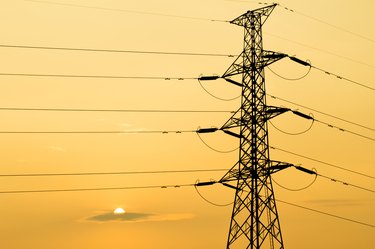
The system of power production and distribution for use in the home relies on a series of different types of lines and poles to keep the juice flowing to your big plasma screen. High-voltage lines carry electricity for hundreds of miles, while low-voltage lines do the work of distributing all that power into homes. Most of these lines crisscrossing the nation are above ground and elevated on the familiar poles that dot the landscape.
Towers
Video of the Day
The workhorses of the electricity grid are the steel superstructures that support the high-voltage lines across great open expanses. These towers are familiar to travelers in remote areas, but they are also present in urban areas, usually in industrial sections in town. After the power leaves the generation plant, it passes through a step-up transformer that raises the voltage exponentially to levels as high as 750 kilovolts, according to the Public Service Commission, or PSC, of Wisconsin.
Video of the Day
The tower height ranges from about 60 to 140 feet in the United States. While the poles are generally double-circuited, meaning they carry two sets of three transmission lines, a few poles are single-circuited. Most towers are steel, but wood is used for some single-circuit transmission poles. They require a right-of-way of 120 feet, according to the PSC, meaning no trees or structures can be nearer than 60 feet on either side. The lines they hold can span from 800 to 1,000 feet before another support tower is required.
Wooden Poles
High-voltage electricity passes through a step-down transformer before it enters the distribution network. Most of these distribution poles are made of wood. There are approximately 134 million wooden power poles in the United States, according to the American Wood Protection Association's estimate. They were the first type of power pole erected in the early days of electricity transmission and distribution. Like towers, they can also be single-poled or double-poled, carrying one or two sets of transmission lines.
The criticism of wooden power poles is mostly environmental, stemming from the logging required to harvest the material and the energy required to manufacture and install them. This has led to the use of alternative materials.
Composite Poles
Composite power poles are made from a combination of materials ranging from reclaimed wood or medium-density fiber to plastics and even fiberglass. Composites gained popularity because of the natural resource drain of wooden poles, but manufacturing the composites themselves requires more energy than milling a wooden pole, according to the Environmental Literacy Council. That means that the overall environmental impact of the composite poles may be greater than the wooden standard bearers.
Steel Poles
Steel is by far the strongest material used in power pole construction, but steel poles require more maintenance than the other varieties. Steel corrodes, shortening the lifespan of the poles, which outweighs the cost benefits gained in the manufacturing process. The National Association of Corrosion Engineers is working to improve mitigation strategies to prolong the life of the poles and prevent premature failure.